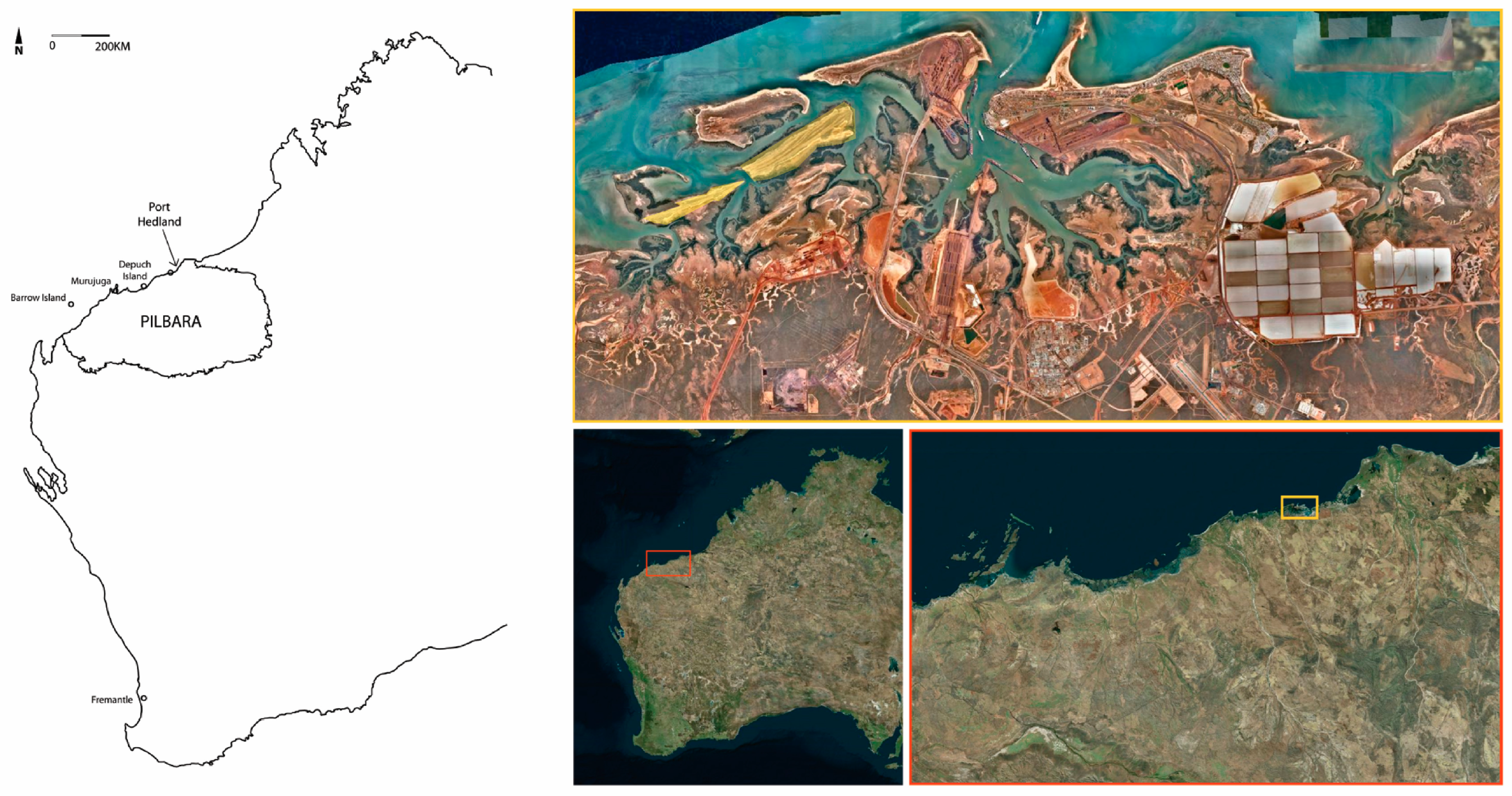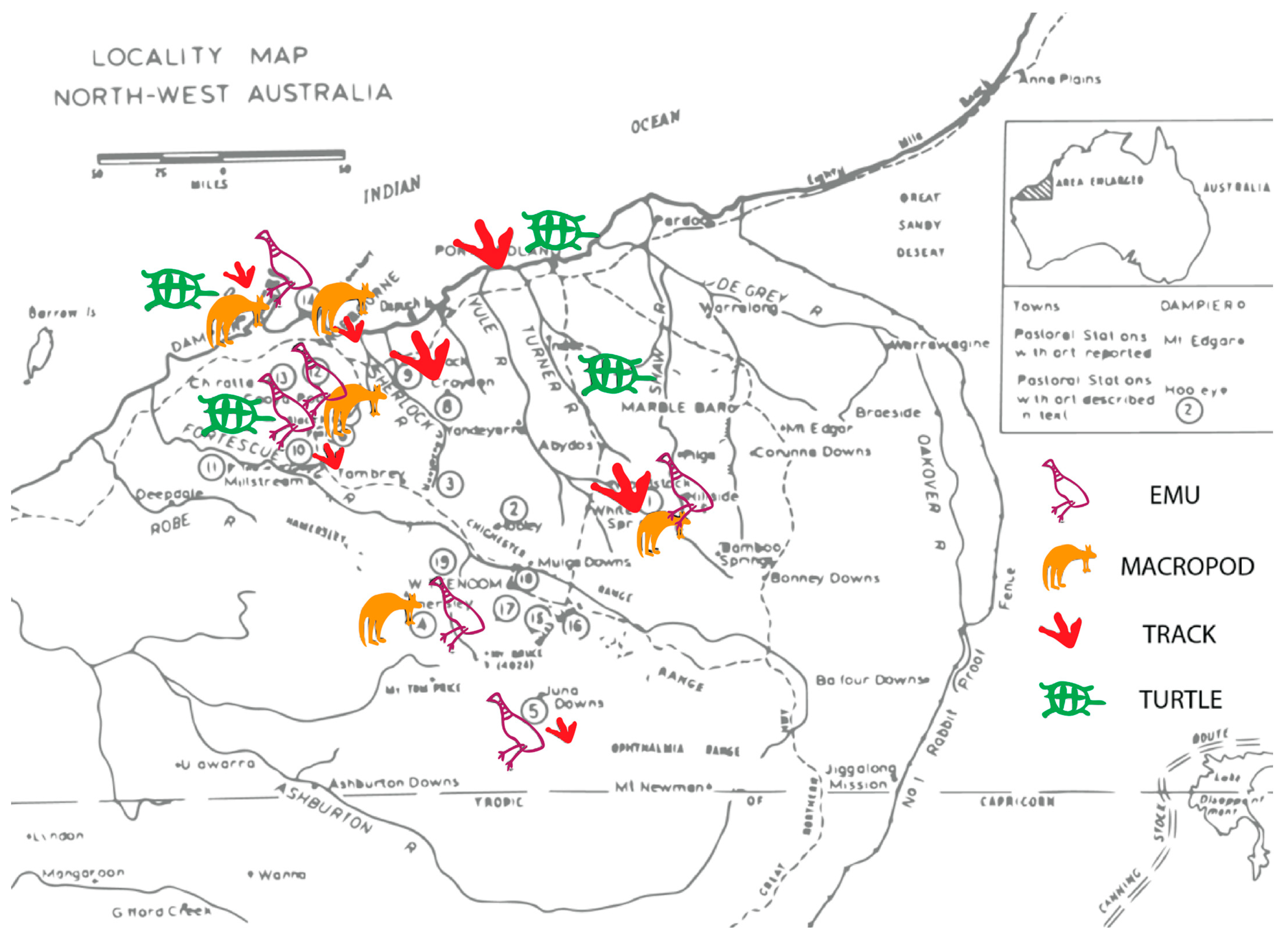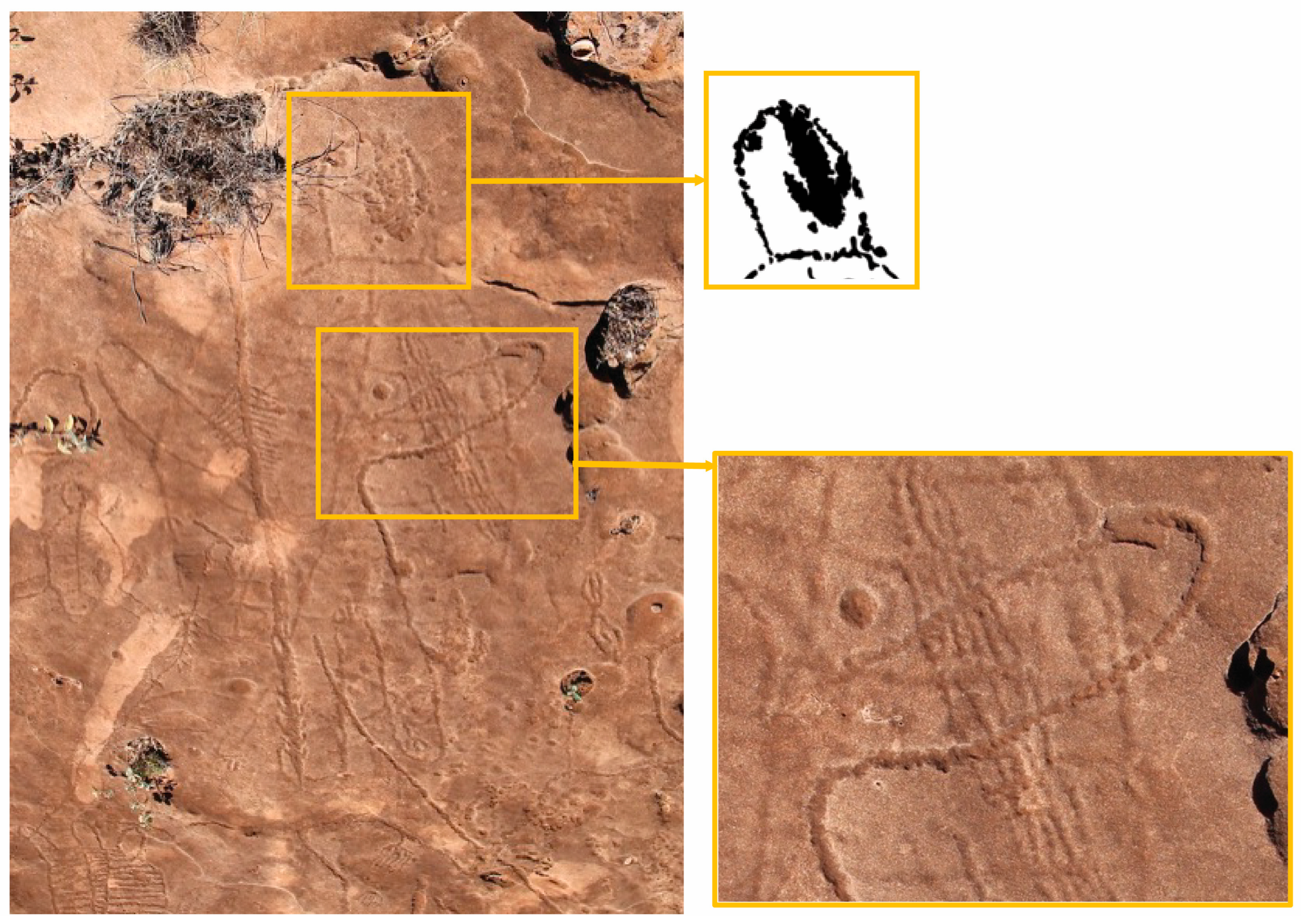Tracking Change in Rock Art Vocabularies and Styles at Marapikurrinya (Port Hedland, Northwest Australia)
Abstract
1. Introduction
2. Background
2.1. Cultural and Environmental Context
2.2. Archaeology and Chronology
- Holocene Climatic Optimum: ~9000–6000 ya;
- El Niño South Oscillation (‘ENSO’) aridity impacts: ~4500–2000 ya; and
- La Niña climatic amelioration and Intensification: ~2000 ya to the present.
2.3. Tracks in Rock Art
2.3.1. Classifying Tracks: Figurative and Geometric Connections
2.3.2. Interpretations: Functional, Ritual, and the Role of Placement
Captain George identified one set of a large and some small human tracks as those of a man chasing a woman; he dropped his spears, shown behind him, became involved in a fight (indicated by the shields and spears in front of him). He also said that the big and the broad tracks are those of Kariyarra men, and the long slender ones are of the Minyiburu.
2.4. Marapikurrinya and the Pilbara
3. Marapikurrinya Tracks
“all forms of overlap are superpositions; superimpositions are a subset that involve the total or near-total overlap of marks or images that ‘map on’ the earlier form. Differentiating between superposition and superimposition in this way allows for a consideration of not only when an image was made, but also how, once on a rock surface, pre-existing images continued to be engaged and activated through time.”
- Outlined/Patterned Figurative: dominated by marine fauna, patterned material culture, and anthropomorphs; large; outline in form with various patterned infill.
- Linear Schematised: dominated by spears, anthropomorphs, and tracks; linear in form; ‘life-size’; schematised.
- Infill Naturalistic: dominated by zoomorphs (marine and terrestrial) and tracks; ‘life-size’; naturalistic and detailed anatomy (Figure 4).
…when I realized that it can never have been possible to delete, or rub out engravings, to clean the blackboard of what was there already. If you tried to draw something new on top of old but still visible engravings, the old would get in the way and make it all an illegible mess. Better to move to a new area.
4. Conclusions
Funding
Institutional Review Board Statement
Informed Consent Statement
Data Availability Statement
Acknowledgments
Conflicts of Interest
References
- Atkins, Lee. 1990. Two Mile Ridge Rock Engraving Site Port Hedland. Canberra: AIATSIS. [Google Scholar]
- Balme, Jane, and Sue O’Connor. 2021. The coming of the dingo. In The Oxford Handbook of the Archaeology of Indigenous Australia and New Guinea. Edited by Ian J. McNiven and Bruno David. Oxford: Oxford University Press, pp. 361–80. [Google Scholar]
- Beard, John Stanley. 1975. Pilbara. Explanatory Notes and Map Sheet 5, 1:100,000 Series Vegetation Survey of Western Australia. Vegetation Series Explanatory Notes to Sheet 5. Nedlands: University of Western Australia Press. [Google Scholar]
- Bowdler, Sandra. 1990. The silver dollar site, Shark Bay: An interim report. Australian Aboriginal Studies 2: 60. [Google Scholar]
- Bradley, Richard. 1997. Death by water: Boats and footprints in the rock art of western Sweden. Oxford Journal of Archaeology 16: 315–24. [Google Scholar] [CrossRef]
- Carden, Natalia. 2009. Prints on the rocks: A study of the track representations from Piedra Museo locality (Southern Patagonia). Rock Art Research 26: 29–42. [Google Scholar]
- Clarke, John. 1978. Deterioration Analysis of Rock Art Sites Conservation of rock art. In Proceedings of the International Workshop on the Conservation of Rock Art, Perth 1977. Edited by Colin Pearson. Perth: Institute for the Conservation of Cultural Material, pp. 54–63. [Google Scholar]
- Clegg, John. 1987. Style and tradition at Sturt’s Meadows. World Archaeology 19: 236–55. [Google Scholar] [CrossRef]
- Clegg, John. 2002. Variability and Information in Rock Art. In Tempus 7: Barriers, Borders, Boundaries: Proceedings of the 2001 Australian Archaeological As Sociation Annual Conference. Edited by Sean Ulm, Catherine Westcott, Jill Reid, Annie Ross, Ian Lilley, Jonathan Prangnell and Luke Kirkwood. Brisbane: University of Queensland, pp. 101–8. [Google Scholar]
- Clottes, Jean. 2015. The identification of human and animal figures in European Palaeolithic art. In Animals into Art. Edited by Howard Morphy. London: Routledge. [Google Scholar]
- Dobrez, Patricia. 2017. From tracks to gesture-derived inscription: An Australian genealogy for’tracks and lines’ petroglyphs. Rock Art Research: The Journal of the Australian Rock Art Research Association (AURA) 34: 149–68. [Google Scholar]
- Dobrez, Patricia. 2018. The body as intelligent tool: The making and reading of trace and trace-derived forms in rock art. Time and Mind 11: 41–66. [Google Scholar] [CrossRef]
- Dortch, Joe, Jane Balme, Jo McDonald, Kate Morse, Sue O’connor, and Peter Veth. 2019. Settling the West: 50,000 years in a changing land. Journal of the Royal Society of Western Australia 102: 30–44. [Google Scholar]
- Edwards, Robert. 1971. Art and Aboriginal Prehistory. In Aboriginal Man and Environment in Australia. Edited by Derek John Mulvaney and Jack Golson. Canberra: Australian National University Press, pp. 356–67. [Google Scholar]
- Eureka Archaeological Research, Gavin Jackson P/L, and Anthropos Australia. 2007. The Report of the Salvage Test Pit Excavations of Selected Aboriginal Archaeological Sites at the Proposed Port and Load-Out Facility at Port Hedland, Pilbara Region. Unpublished report prepared for the Pilbara Native Title Service & Fortescue Metals Group Pty Ltd. [Google Scholar]
- Franklin, Natalie. R. 2004. Explorations in Variability in Australian Prehistoric Rock Engravings. Oxford: British Archaeological Reports. [Google Scholar]
- Frederick, Ursula K. 1999. At the centre of it all: Constructing contact through the rock art of Watarrka National Park, central Australia. Archaeology in Oceania 34: 132–44. [Google Scholar] [CrossRef]
- Green, Jennifer. 2014. Drawn from the Ground: Sound, Sign and Inscription in Central Australian sand Stories. Language, Culture and Cognition 13. Cambridge: Cambridge University Press. [Google Scholar]
- Gunn, Robert G., Bruno David, Jean-Jacques Delannoy, Benjamin Smith, Augustine Unghangho, Ian Waina, Leigh Douglas, Cecilia Myers, Pauline Heaney, Sven Ouzman, and et al. 2022. Superpositions and superimpositions in rock art studies: Reading the rock face at Pundawar Manbur, Kimberley, northwest Australia. Journal of Anthropological Archaeology 67: 101442. [Google Scholar] [CrossRef]
- Harper, Sam. 2016. Outlining the Port Hedland style: A distinctive local signature within the broader shared iconographies of the Pilbara, northwest Australia. Journal of the Anthropological Society of South Australia 40: 70–107. [Google Scholar]
- Harper, Sam. 2017. Inside the Outline: Understanding Inclusive and Exclusive Identity in Marapikurrinya (Port Hedland) Rock Art. Ph.D. thesis, University of Western Australia, Perth, Australia. [Google Scholar]
- Harrison, Rodney. 2009. The archaeology of Port Hedland coastal plain and implications for understanding the prehistory of shell mounds and middens in northwestern Australia. Archaeology in Oceania 44: 81–98. [Google Scholar] [CrossRef]
- Jennings, J. N. 1975. Desert dunes and estuarine fill in the Fitzroy estuary (north-western Australia). Catena 2: 215–62. [Google Scholar] [CrossRef]
- Kendrick, George W., and Kate Morse. 1990. Evidence of recent mangrove decline from an archaeological site in Western Australia. Australian Journal of Ecology 15: 349–53. [Google Scholar] [CrossRef]
- Lenssen-Erz, Tilman, Andreas Pastoors, Thorsten Uthmeier, Tsamgao Ciqae, Ui Kxunta, and Thui Thao. 2023. Animal tracks and human footprints in prehistoric hunter-gatherer rock art of the Doro! nawas mountains (Namibia), analysed by present-day indigenous tracking experts. PLoS ONE 18: e0289560. [Google Scholar] [CrossRef]
- Lewis, Stephen E., Craig R. Sloss, Colin V. Murray-Wallace, Colin D. Woodroffe, and Scott G. Smithers. 2013. Post-glacial sea-level changes around the Australian margin: A review. Quaternary Science Reviews 74: 115–138. [Google Scholar] [CrossRef]
- Maynard, Lesley. 1979. The archaeology of Australian Aboriginal art. In Exploring the visual art of Oceania: Australia, Melanesia, Micronesia and Polynesia. Edited by Sidney M. Mead. Honolulu: University Press of Hawai’I, pp. 83–110. [Google Scholar]
- McCarthy, Frederick D. 1962. The Rock Engravings at Port Hedland, Northwestern Australia. Berkeley: University of California, Kroeber Anthropological Society. [Google Scholar]
- McDonald, Jo. 2015. I must go down to the seas again: Or, what happens when the sea comes to you? Murujuga rock art as an environmental indicator for Australia’s north-west. Quaternary International 385: 124–35. [Google Scholar] [CrossRef]
- McDonald, Jo. 2017. Discontinuities in arid zone rock art: Graphic indicators for changing social complexity across space and through time. Journal of Anthropological Archaeology 46: 53–67. [Google Scholar] [CrossRef]
- McDonald, Jo. 2022. The Sydney School and the genesis of contemporary Australian rock art research. In Histories of Australian Rock Art Research. Series: Terra Australis. Canberra: ANU, pp. 43–71. [Google Scholar]
- McDonald, Jo, and Megan Berry. 2017. Murujua, Northwestern Australia: When Arid Hunter-Gatherers Became Coastal Foragers. The Journal of Island and Coastal Archaeology 12: 24–43. [Google Scholar] [CrossRef]
- McDonald, Jo, and Peter Veth. 2013. Rock art in arid landscapes: Pilbara and Western Desert petroglyphs. Australian Archaeology 77: 66–81. [Google Scholar] [CrossRef]
- McDonald, Jo, and Sam Harper. 2016. Identity signalling in shields: How coastal hunter-gatherers use rock art and material culture in arid and temperate Australia. Australian Archaeology 82: 123–38. [Google Scholar] [CrossRef]
- McDonald, Josephine, and Peter Veth. 2011. Information Exchange amongst Hunter-Gatherers of the Western Desert of Australia. In Information and Its Role in Hunter-Gatherer Bands: Ideas, Debates and Perspectives. Edited by Robert Whallon, William A. Lovis and Robert K. Hitchcock. Los Angeles: UCLA/Cotsen Institute of Archaeology Press, pp. 221–33. [Google Scholar]
- Mithen, Steven J. 1988. Looking and learning: Upper Palaeolithic art and information gathering. World Archaeology 19: 297–327. [Google Scholar] [CrossRef]
- Morse, Kate, Richard Cameron, and Wendy Reynen. 2014. A tale of three caves: New dates for Pleistocene occupation in the inland Pilbara. Australian Archaeology 79: 167–78. [Google Scholar] [CrossRef]
- Motta, Ana P., and Peter M. Veth. 2021. Relational ontologies and performance: Identifying humans and nonhuman animals in the rock art from north-eastern Kimberley, Australia. Journal of Anthropological Archaeology 63: 101333. [Google Scholar] [CrossRef]
- Mountford, Charles P. 1937. Rock paintings at Windulda, Western Australia. Oceania 7: 429–35. [Google Scholar] [CrossRef]
- Mulvaney, Ken. 2015. Murujuga Marni: Rock Art of the Macropod Hunters and Mollusc Harvesters. Nedlands: UWA Publishing. [Google Scholar]
- Munn, Nancy D. 1973. Walbiri Iconography: Graphic Representation and Cultural Symbolism in a Central Australian Society. Ithaca: Cornell University Press. [Google Scholar]
- Ouzman, Sven, Paul S. Taçon, Ken Mulvaney, and Richard Fullager. 2002. Extraordinary engraved bird track from north Australia: Extinct fauna, dreaming being and/or aesthetic masterpiece? Cambridge Archaeological Journal 12: 103–12. [Google Scholar] [CrossRef]
- Paling, Eric I. 2002. Assessment of Issues Relating to Acid Sulphate Soils in Port Hedland August 2002. Perth: Report to Government of Western Australia Department of Environment Regulation. [Google Scholar]
- Palmer, Kingsley. 1977. Myth, Ritual and Rock Art. Archaeology & Physical Anthropology in Oceania 12: 38–50. [Google Scholar]
- Rosenfeld, Andrée. 1991. Panaramitee, dead or alive? Aboriginal rock art styles. In Rock art and prehistory: Papers presented to Symposium G of the Aura Congress, Darwin. Edited by Paul Bahn and Andrée Rosenfeld. Oxford: Oxbow Books, pp. 136–44. [Google Scholar]
- Rosenfeld, Andrée. 2002. Rock-Art as an Indicator of Changing Social Geographies in Central Australia. In Marking and Making Place. Edited by Bruno David and Meredith Wilson. London: Routledge, pp. 61–78. [Google Scholar]
- Schaafsma, Polly. 2015. Supper or Symbol: Roadrunner tracks in southwest art and ritual. In Animals into Art. Edited by Howard Morphy. London: Routledge, pp. 262–79. [Google Scholar]
- Semeniuk, V. 1996. Coastal forms and Quaternary processes along the arid Pilbara coast of northwestern Australia. Palaeogeography, Palaeoclimatology, Palaeoecology 123: 49–84. [Google Scholar] [CrossRef]
- Semeniuk, V., and D. P. Johnson. 1982. Recent and Pleistocene beach/dune sequences, Western Australia. Sedimentary Geology 32: 301–28. [Google Scholar] [CrossRef]
- Slack, Michael, Boone Law, and Luke Gliganic. 2018. Pleistocene settlement of the eastern Hamersley Plateau: A regional study of 22 rock-shelter sites. Archaeology in Oceania 53: 191–204. [Google Scholar] [CrossRef]
- Slack, Michael J., W. Boone Law, Adelle C. Coster, Kane Ditchfield, Judith Field, Jillian Garvey, and Puutu Kunti Kurrama. 2024. A 47,000 year archaeological and palaeoenvironmental record from Juukan 2 rockshelter on the western Hamersley Plateau of the Pilbara region, Western Australia. Quaternary Science Reviews 338: 108823. [Google Scholar] [CrossRef]
- Sullivan, Marjorie, Philip Hughes, and Anthony Barham. 2011. Changing Perspectives in Australian Archaeology, part II. Abydos Plain—Equivocal archaeology. Technical Reports of the Australian Museum 23: 7–29. [Google Scholar] [CrossRef]
- Tindale, Norman B. 1974. Aboriginal Tribes of Australia. Berkeley: University of California Press. [Google Scholar]
- Veitch, B. 1999. Shell middens on the Mitchell Plateau: A reflection of a wider phenomenon. In Australia Coastal Archaeology. Edited by Jay Hall and Ian J. McNiven. Canberra: ANH Publications, pp. 51–64. [Google Scholar]
- Veth, Peter, K. Ditchfield, and Fiona Hook. 2014. Maritime deserts of the Australian northwest. Australian Archaeology 79: 156–66. [Google Scholar] [CrossRef]
- Walker, Nick. 1996. In the footsteps of the ancestors: The Matsieng creation site in Botswana. The South African Archaeological Bulletin 52: 95–104. [Google Scholar] [CrossRef]
- Warren, L. 1995. A report of a preliminary archaeological survey of proposed hot briquetted iron quarry areas on Boodarie Station, near Port Hedland, W.A. An unpublished report prepared for BHP Billiton. [Google Scholar]
- Williams, Alan N., Sean Ulm, Chris S. Turney, David Rohde, and Gentry White. 2015. Holocene demographic changes and the emergence of complex societies in prehistoric Australia. PLoS ONE 10: e0128661. [Google Scholar] [CrossRef]
- Woodroffe, Colin D., B. G. Thom, and John Chappell. 1985. Development of widespread mangrove swamps in mid-Holocene times in northern Australia. Nature 317: 711–13. [Google Scholar] [CrossRef]
- Wright, Bruce J. 1968. Rock Art of the Pilbara region, North-West Australia. Canberra: Australian Institute of Aboriginal Studies, Vol. 11. [Google Scholar]
- Wright, Bruce J. 1977. Schematisation in the rock engravings of north-western Australia. In Form in Indigenous Art: Schematisation in the Art of Aboriginal Australia and Prehistoric Europe. Edited by Peter J. Ucko. Canberra: Australian Institute of Aboriginal Studies, pp. 110–18. [Google Scholar]
- Young, M. Jane. 1985. Images of power and the power of images: The significance of rock art for contemporary Zunis. The Journal of American Folklore 98: 3–48. [Google Scholar] [CrossRef]






| Rock Art Style | Proposed Age-Range Estimates | Climatic Context | Tracks (Figure 4) |
|---|---|---|---|
| Outlined/Patterned Figurative | ~7–5000 ya | Holocene climatic optimum and sea-level stabilisation, Marapikurrinya becomes a seascape place—after rapid coastal shelf loss | Almost absent |
| Linear Schematised | ~5–1000 ya | ENSO and increasing aridity; resource stress | Dominated by three- and four-toed bird tracks; macropod tracks/trails; simplified, ‘quick’. |
| Infill Naturalistic | 1000 ya–present | Climatic amelioration, increasing ritual exchange with arid zone and desert | Array of animals with terrestrial and intertidal birds, noticeable emu tracks; macropods (including array of postures/scenes); dingo, increase in track superimpositions |
Disclaimer/Publisher’s Note: The statements, opinions and data contained in all publications are solely those of the individual author(s) and contributor(s) and not of MDPI and/or the editor(s). MDPI and/or the editor(s) disclaim responsibility for any injury to people or property resulting from any ideas, methods, instructions or products referred to in the content. |
© 2025 by the author. Licensee MDPI, Basel, Switzerland. This article is an open access article distributed under the terms and conditions of the Creative Commons Attribution (CC BY) license (https://creativecommons.org/licenses/by/4.0/).
Share and Cite
Harper, S. Tracking Change in Rock Art Vocabularies and Styles at Marapikurrinya (Port Hedland, Northwest Australia). Arts 2025, 14, 123. https://doi.org/10.3390/arts14050123
Harper S. Tracking Change in Rock Art Vocabularies and Styles at Marapikurrinya (Port Hedland, Northwest Australia). Arts. 2025; 14(5):123. https://doi.org/10.3390/arts14050123
Chicago/Turabian StyleHarper, Sam. 2025. "Tracking Change in Rock Art Vocabularies and Styles at Marapikurrinya (Port Hedland, Northwest Australia)" Arts 14, no. 5: 123. https://doi.org/10.3390/arts14050123
APA StyleHarper, S. (2025). Tracking Change in Rock Art Vocabularies and Styles at Marapikurrinya (Port Hedland, Northwest Australia). Arts, 14(5), 123. https://doi.org/10.3390/arts14050123






